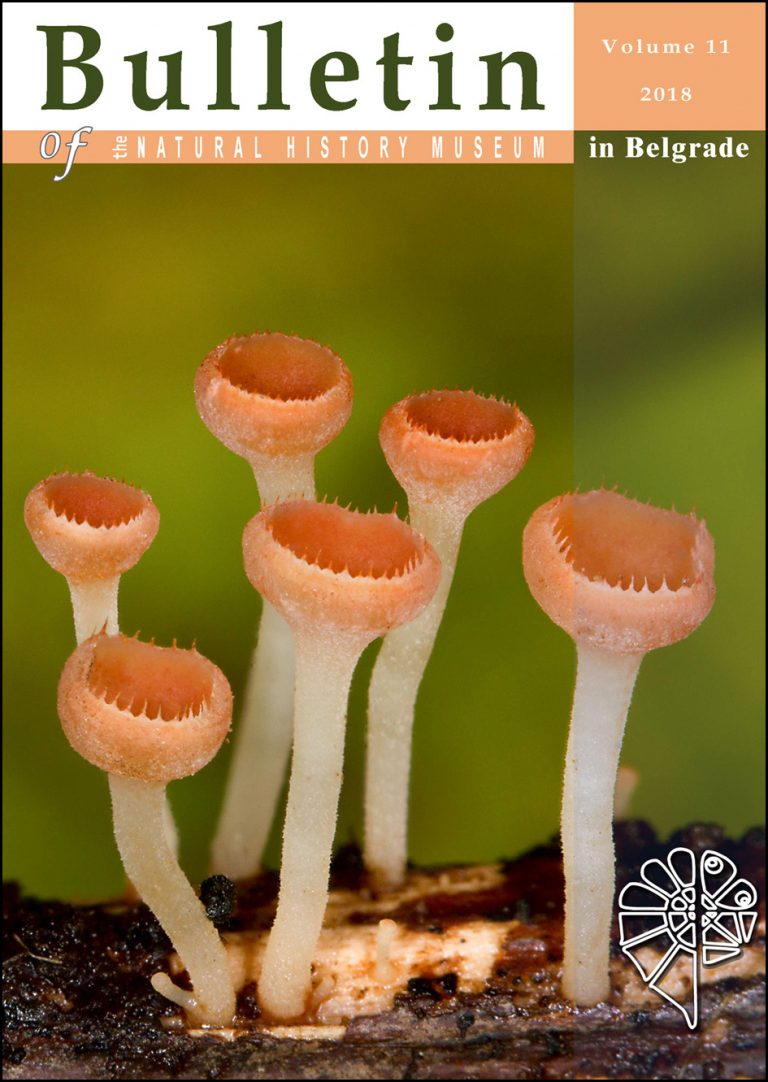
Geology
Marković, Z., Milivojević, M., de Bruijn, H., Wessels, W., van de Weerd, A. A., Renovica, S., Šišić, E., Modrić, K.
Paleontological research on fossil small mammals from the open-pit coal mines of Bosnia and Herzegovina – Overview of results
Fossil remains of Tertiary small mammals were found on four open-pit coal mines in Bosnia and Herzegovina. Three of them are the Oligocene/Oligo-Miocene in age “Bogutovo Selo” and “Luke Mezgraja” – Ugljevik Basin and “Turija” – Banovići Basin), while one belongs to the Middle Miocene, “Gračanica” – Bugojno Basin.
Keywords: Tertiary, small mammals, coal mines, Bosnia and Herzegovina
Biology
Savić, D., Kajevska, I., Milosavljević, N.
Checklist of Pezizomycetes from Serbia
In this paper, report on species distribution from the class Pezizomycetes is presented, in the Republic of Serbia. The list of species contains all known published and unpublished data so far. To date, a total number of 206 species have been listed, of which even 105 have been recognized as new country records. This comprehensive species list significantly enriches the knowledge of this taxonomic group in the country.
Key words: Fungi, Ascomycota, Southeast Europe
Perić, R., Knežević, J., Škondrić, S.
Materials for a flora of Serbia from the herbarium collection PZZP (1)
The Herbarium collection of the Institute for Nature Conservation of the Vojvodina province (PZZP) is one of the least known institutional collections in Serbia. In this article is presented the first part of results of the ongoing process of examination and revision of this collection. It covers data on interesting, new and noteworthy vascular plant taxa from 6 genera (Cytisus L., Lamium L., Lappula Moench, Lathyrus L., Leersia Sw. and Legousia Durande) included in 18 species, 5 subspecies, 3 varieties, 4 forms, as well as 4 taxa with undetermined status [stat. indet.] and one supposed nothospecies. One species and subspecies (Lappula heteracantha subsp. heterocarpa) and 5 taxa on the different infraspecific levels are new for a flora of Serbia.
Key words: botanical collections, flora, chorology, Serbia
Niketić, M., Tomović, G., Perić, R., Zlatković, B., Anačkov, G., Đorđević, V., Jogan, N., Radak, B., Duraki, Š., Stanković, M., Kuzmanović, N., Lakušić, D., Stevanović, V.
Material on the Annotated Checklist of Vascular Flora of Serbia. Nomenclatural, taxonomic and floristic notes I.
The paper presents three new nomenclature combinations related to representatives of the orchid family. In addition, 14 taxa (species, subspecies and hybrids) of vascular flora which are newly registered for Serbia (of which 8 are autochthonous and 6 allochtonous plants) are presented. A confirmation of old or unreliable literature records for four autochthonous and one allochthonous plant in the flora of Serbia has been done. Four plant taxa are a novelty for proper Serbia, Vojvodina, or Kosovo and Metohija, and for 7 plants, presence in certain administrative units in Serbia has been confirmed. In the last part of the paper, there is a review of 9 disputed taxa for our country.
Key words: vascular flora, checklist, nomenclature, taxonomy, Serbia
Niketić, M., Tomović, G., Siljak-Yakovlev, S.
A new spontaneous hybrid between the cultivated and wild Iris species from Serbia
A new spontaneous wilding hybrid, Iris ×seminaturalis Niketić, Tomović & Šiljak-Yak. (I. ×germanica L. s.l. × I. reichenbachii Heuff.) from C Serbia was described and illustrated. The comparative analyses of the morphological characters and genome sizes were performed on I. ×seminaturalis and its parents. A new taxonomic review of the complex I. ×germanica s.l. was also presented.
Key words: vascular flora, Iris ×seminaturalis, Iris ×germanica, spontaneous hybrid, Serbia
Koopman, J., Więcław, H.
On the alleged presence of Carex atherodes (Cyperaceae) in Serbia
Protić, Lj.
New Heteroptera in Serbia
This paper presents 13 species new for Heteroptera fauna of Serbia: Family Miridae: Apolygus rhamnicola (Reuter, 1885), Dichrooscytus intermedius Reuter, 1885; Lygocoris viridis (Fallén, 1807); Euryopicoris nitidus (Meyer-Dür, 1843); Halticus major Wagner 1951; Strongylocoris atrocoeruleus (Fieber, 1864); Megalocoleus naso (Reuter,1879); Orthonotus pseudoponticus Josifov, 1964; Orthonotus syriacus (Puton, 1881); Parapsallus vitellinus (Scholtz, 1847); Psallus (Psallus) varians varians (Herrich-Schaeffer, 1841); family Lygaeidae: Lygaeus simulans Deckert, 1985; family Pentatomidae: Aelia melanota Fieber, 1868. Also presented are the first data on Lygaeus simulans for Montenegro.
Key words: Heteroptera, Serbia, Balkan Peninsula
Urošević, A., Tomović, Lj., Krizmanić, I., Anđelković, M., Golubović, A., Maričić, M., Ajtić, R., Ćorović, J., Čubrić, T., Tomašević-kolarov, N., Cvijanović, M., Vukov, T., Jovanović, B., Vučić, T., Ajduković, M., Tot, I., Nadaždin, B., Labus, N., Džukić, G.
Distribution and diversity of brown frogs (Rana spp., Anura, Amphibia) in Serbia
In this study, we present updated distribution data for all three brown frog species (Rana spp.) inhabiting Serbia. The data provided consists of newly collected field records and compiled data previously published in literature or via Internet. Of the three species found in Serbia, Rana dalmatina is the most widespread, present in all three altitudinal regions and all biogeographical regions. Rana graeca is confined to Mountain-valley altitudinal region in permanent fast-flowing rivers or streams and it reaches its northern range boundaries in Serbia. Rana temporaria is the rarest of the three, with fragmented range restricted to the high mountains or few isolated lowland populations, and in the north-eastern Serbia, it is vicariant with R. graeca in canyons and gorges of montane rivers. The presence of Rana arvalis in Serbia is mentioned in literature but was not confirmed during the subsequent field surveys, so we consider it only as a potential species for the Serbian batrachofauna. The brown frog faunal composition of Serbia is identical to that of Albania, Bosnia and Herzegovina, Bulgaria, Greece, Macedonia and Montenegro, while it is somewhat different from that of Hungary and Romania and the most different from Croatia and Slovenia. Serbian brown frogs belong to European (R. temporaria) and South-European (R. dalmatina, R. graeca) chorotypes. All species of brown frogs present or potentially present in Serbia and their habitats are identified as great conservation priorities.
Keywords: Distribution, diversity, Rana, zoogeography
In memoriam
Vasić, O.
The years and paths of Nikola Diklić. (1925-2008). Ten years after


